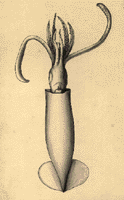William Evans Hoyle (1855-1926)

William Evans Hoyle (1855-1926)
The major holding of cephalopods in the Museum is the collection of W. Evans HOYLE (1855 - 1926). His collection resides here because Hoyle was the first director of this institution from 1909 to 1924. The collection is relatively small, 463 lots, but is a sample of most of the major studies undertaken by Hoyle from 1883 - 1912.
Hoyle is most famous for the monographic studies on cephalopods from the major exploring expeditions of his era, notably, "Challenger"; "Albatross"; British National Antarctic Expedition; Scottish National Antarctic Expedition. He similarly studied material collected by Herdman from the Gulf of Manaar; Crossland from Zanzibar and Stanley Gardner from the Maldives & Laccadives.
Trained as a medical anatomist his cephalopod studies show the skill in fine dissection and he wrote a number of papers on aspects of cephalopod structure. He was also responsible for bringing together a comprehensive catalogue of recent cephalopoda firstly in 1886 and subsequently revised in 1897 and 1909.
For further details of Hoyle's life see Jackson, J. W. 1926. Journal of Conchology, 18 (2) 33-34. and for a list of molluscan papers Melvill, J. C. in the same publication but pages 71-74.
The collection of cephalopods is stored in the sequence according to Voss (1977) and represents 42 genera and xxx nominal species level taxa. There are a few primary types but much of the collection is cited in Hoyle's papers. A vast amount of material passed through Hoyle's hands and his hand written catalogue lists these. As much was on loan it was duly returned and for example the bulk of the "Challenger" collection is in the NHM London and the "Albatross" collection in the Smithsonian in Washington. Hoyle did however keep some material and we encourage cephalopods researchers to browse this site especially for material they feel ought to have been elsewhere. Obviously this site should be browsed for any material cited in Hoyle's papers.
The identification of the cephalopods remains as it was when Hoyle bequeathed the collection and this should be remembered when browsing. We are willing to upgrade the determinations but believe that the original names allow better referencing to Hoyle's papers.


Hoyle would appear to have been a meticulous researcher and has retained a considerable quantity of his manuscript papers, including many original line illustrations. Typical of this material is the first proof of his 1885 paper on Loligopsis which is extensively annotated by Steenstrup and is accompanied by a hand written letter from Steenstrup dated 29/1/1885. There is some unpublished material such as the description and illustrations of Hemisepius typicus based on two specimens collected by the Scottish National Antarctic Expedition from Saldahna Bay. His report only mentions the occurrence and we have no clue as to why his extensive notes and drawings were never used. There are other rough papers such as an outline of the evolutionary sequence of Sepia species and a four page table of the characters of the species of Polypus (Octopus).
Hoyle, as with many of is colleagues of the day also collected ephemera related to their subject and there exists a collection of letters from contemporary cephalopod researchers. Of note is a postcard (02/07/1889) from Pelseneer on the osphradium of Taonius and a letter (29/10/ 1898) from Joubin on Leptoteuthis.
Hoyle also amassed a library on cephalopods and this was augmented much later by the Tomlin bequest of 1955. Together there is an extensive set of books and reprints. These range from standard monographic works such as Chun (1910), Pfeffer (1912) d'Orbigny (1835) and Verany (1851) to obscure studies such as Bobretzky (1877) in Russian on cephalopod development but with a hand written German translation inserted. There are series of standard reprints of authors such as Steentrup and Joubin but there are early offprints such as Lamarck (1799) on "Les genres de la Seche, du Calamar et du Poulpe"; Trinchese (1868) on the nervous system; Krohn (1833) on the cephalopod eye; Vrolik (1856) on Nautilus and Leach (1817) on Ocythoe. The library is open to consultation by appointment and lending is subject to strict inter-library conditions.